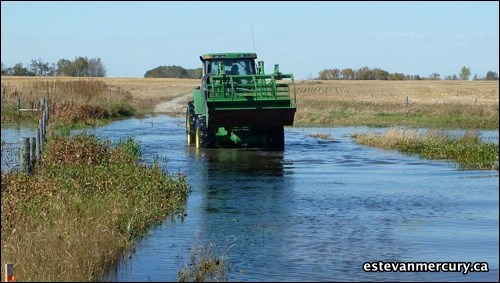The Sloan family is another in a long list of rural Saskatchewan residents frustrated by last year's flooding and how it's been dealt with.
Howard and Kathy Sloan are at the bottom of the trail of water that has been making its way east, after they said landowners and municipalities have been draining the spring's flood waters from one municipality to the next. These measures, Kathy added, were necessary to save some towns, but because the draining wasn't done as part of a concerted effort, everyone else has had to deal with the consequences on their own.
"They drain land with no thought to the consequences of what happens," Kathy said.
One of the issues they take with how the situation has been dealt with is that laws are in place that prevent water being drained from one area to the one below it. Kathy said the Saskatchewan Watershed Authority is supposed to provide a stamp of approval if a road is to be cut or land altered in order to drain a field.
Approval for the drainage alteration project initiated by the RM of Browning and Town of Lampman was not granted as of Nov. 14, according to a letter the Sloans received from the Ministry of Municipal Affairs.
The problems for the Sloans, who live on a farm just outside of Alameda, started in July. The water problem in the southeast started well before that. The water they are receiving is coming from 100 miles away, they said. The water from around Yellow Grass was being diverted all the way down to the Alameda Dam. So that water must pass through two ravines, one of which is Shallow Creek, that runs through the Sloan's property.
The decision was made to run the water down to Alameda, but "no one came to talk to us on anything," said Sloan.
The water on their property is still as high now as it was with a full spring runoff.
The Sloans are also concerned by the loss of viable acres for seeding, so, in a letter, they asked the Ministry of Agriculture if crop insurance would "cover the unseeded acres attributed to the alterations of drainage on an annual basis."
The Ministry replied that "the benefit is designed to provide coverage on acres that would normally be seeded when excess moisture is a concern ... Land that is perpetually too wet to seed is not intended to be covered by insurance."
They are also frustrated by what they call a "passing of the buck" by the SWA, which includes a new SWA board of seven members representing 21 communities.
The Sloans attended a meeting on Dec. 12 at the RM of Browning office, after which they gave the RM and SWA a tour of their property to see the flooded ravines. At a meeting on Jan. 16 that they weren't invited to, they said the decision was announced by the SWA that they were planning on draining Lake Roy, northwest of Lampman.
SWA officials were not immediately available to comment on that situation.




